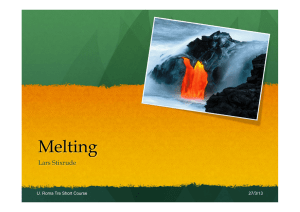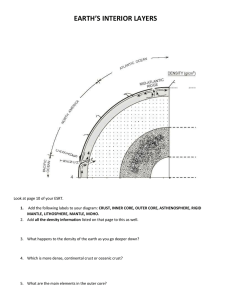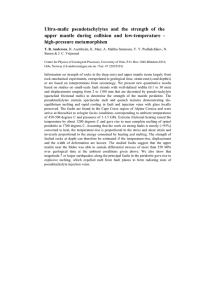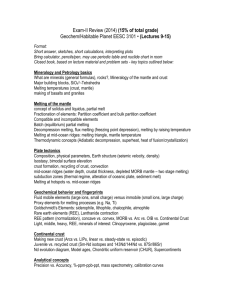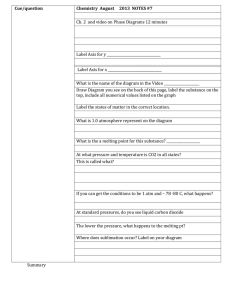work on hotspot volcanism and the geochemistry of Hawaiian lavas
advertisement
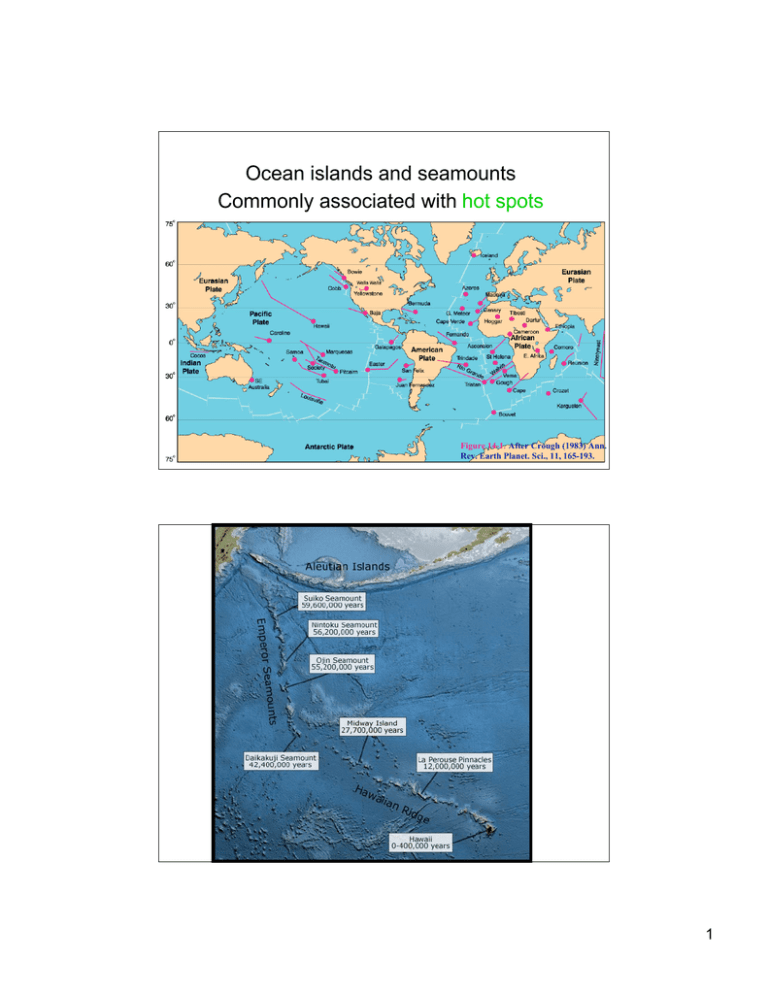
Ocean islands and seamounts Commonly associated with hot spots Figure 14-1. After Crough (1983) Ann. Rev. Earth Planet. Sci., 11, 165-193. 1 2 3 KO!OLAU VOLCANO Shield stage (tholeiite) = Ko!olau Volcanics Post-erosional stage (nephelinites) = Honolulu Volcanics Geologic map of O‘ahu, generalized from this publication’s digital map database. Geology from Stearns (1939) and J.M. Sinton (this map). Inset bathymetric map from Eakins and others (2003). 4 5 Modeling Rare-Earth Elements (REE) during Mantle Melting beneath Hawaii 1) What do we use for the mantle mineralogy? 60% olivine; 25% opx; 10% cpx; 5% garnet 2) What do we start with for initial REE concentrations? primitive mantle or chondritic compositions 3) What process do we model? equilibrium partial melting 4) What equation do we use? An example of an olivine-clinopyroxene bearing mantle xenolith from the 1800-1801 lava flow of Hualalai. A thin coating of host lava mantles the rock (image on right is about 15 cm wide) 6 7 Modeling Rare-Earth Elements (REE) during Mantle Melting beneath Hawaii 4) What equation do we use? CL = ! CO (F + D(1" F)) CL – measure in erupted magma CO – unknown (assume primitive mantle) D – calculate from lab data F – unknown (estimate range) How will the REE partition between minerals (solid) and melt during partial melting? 8 REE Model for Hawaii Mantle Melting Mineral proportion DCerium DYtterbium 60% 0.001 0.002 Orthopyroxene 25% 0.003 0.05 Clinopyroxene 10% 0.1 0.28 Garnet 5% 0.02 4.0 (Spinel) (5%) (0.08) (0.02) Olivine Calculate DCe for the whole rock: D Ce(bulk) = (0.60*0.001) + (0.25*0.003) + (0.10*0.1) + (0.05*0.02) = 0.012 Calculate DYb for the whole rock: DYb(bulk) = (0.60*0.002) + (0.25*0.05) + (0.10*0.28) + (0.05*4.0) = 0.242 (For spinel peridotite: DCe(bulk) = 0.015 DYb(bulk) = 0.043 ) Modeling Rare-Earth Elements (REE) during Mantle Melting beneath Hawaii 4) What equation do we use? CL = ! CL – measure in erupted magma CO – unknown (assume primitive mantle) D – calculate from lab data F – unknown (estimate range) CO (F + D(1" F)) Start with an extreme value: F = 0 CL 1 = CO D What do we expect for an extremely small fraction of partial melting? …… ! 9 As calculated in the trace element lab D At F = 0, have the maximum enrichment possible in liquid; i.e., 1/D 83.3 16.3 4.1 3.6 Assume starting composition is chondritic (all elements at 1.0) At F=0 get maximum enrichment of REE in melt; Ce = 83 x chond. At more reasonable F=5%, get Ce = 16 x chond. 10 83.3 16.3 4.1 3.6 83.3 16.3 4.1 3.6 11 Ce/Th " 40/2.5 = 16 Ce/Th " 160/10 = 16 DCe " DTh " 0 What can we calculate? Modeling Rare-Earth Elements (REE) during Mantle Melting beneath Hawaii 4) What equation do we use? CL = CL – measure in erupted magma CO – unknown (assume primitive mantle) D – calculate from lab data F – unknown (estimate range) CO (F + D(1" F)) !For Ce and Th in Honolulu Volcanics: D CL 1 = CO F =0 So can we use this to put any limits on the fraction of partial melting? …… ! 12 Ce/Th " 40/2.5 = 16 Ce/Th " 160/10 = 16 DCe " DTh " 0 CL/CO " 1/F (2 equations, 2 unknowns) Modeling Rare-Earth Elements (REE) during Mantle Melting beneath Hawaii For Ce and Th in Honolulu Volcanics: D = 0 So can we use this to put any limits on the fraction of partial melting? …… CL 1 = CO F For 2 magmas, A & B, [Th]A = 12 ppm, [Th]B = 2.4 ppm (are values for CL). We don’t know CO, but since magmas are from same source, [CO]A = [CO]B. Magma A formed by partial melt fraction FA; and magma B by FB. ! Write the above equation for both magmas, and divide one by the other: CLA CLA FB 12 COA FB A B = since CO = CO = = B CLB FA C F 2.4 L A COB Magma B formed by 5x as much melting as magma A =5 ! ! ! 13 14
